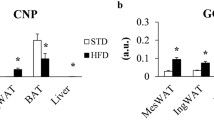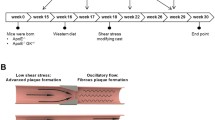Abstract
The metabolic syndrome (MS), a condition characterized by several risk factors for coronary artery disease, including obesity, is associated with endothelial dysfunction and oxidative stress. Because proper endothelial function is essential for signaling of certain growth factors (vascular endothelial growth factor, VEGF) we hypothesized that coronary collateral growth (CCG) is impaired in a model of the MS. To test this hypothesis, we stimulated coronary collateral growth in pre-diabetic Zucker obese fatty rats (OZR) and lean littermates (LZR) by using episodic, repetitive ischemia (RI: 40 s left anterior descending arterial occlusion, 24/d for 14 d). Myocardial blood flow (MBF, radioactive microspheres) was measured in the normal (NZ) and collateral-dependent (ischemic) zones (CZ); CCG was assessed as a ratio of CZ/NZ flow (unity represents complete restoration of CZ flow). In LZR, CZ/NZ ratio increased from 0.18 ± 0.03 to 0.81 ± 0.07 after RI (P < 0.05). In contrast, in OZR rats CZ/NZ did not increase after RI (0.15 ± 0.04 vs 0.18 ± 0.04). To rectify abrogated collateral growth in OZR, we employed VEGF gene therapy (VEGF-transduced, strained-matched, cultured vascular smooth muscle cells [cVSMCs], delivered intracoronary). VEGF therapy modestly but not significantly increased the CZ/NZ ratio after RI (0.16 ± 0.05 vs 0.33 ± 0.06). To facilitate VEGF signaling,we reduced oxidative stress by transducing cVSMCs with both ecSOD and VEGF. This increased the CZ/NZ flow ratio after RI to 0.52 ± 0.04 (p < 0.05 vs. OZR [(0.19 ± 0.04]) indicating partial restoration of collateral growth. Our results demonstrate that coronary collateral growth is impaired in a model of the metabolic syndrome and that growth factor gene therapy with VEGF is made far more effective when it is coupled to an intervention that reduces oxidative stress.
Similar content being viewed by others
References
Brzezinska AK, Lohr N, Chilian WM (2005) Electrophysiological effects of O2*- on the plasma membrane in vascular endothelial cells. Am J Physiol Heart Circ Physiol 289:H2379–H2386
Chilian WM, Mass HJ, Williams SE, Layne SM, Smith EE, Scheel KW (1990) Microvascular occlusions promote coronary collateral growth. Am J Physiol Heart Circ Physiol 258: H1103–H1111
Feletou M, Vanhoutte P (2006) Endothelial dysfunction: a multifaceted disorder (The Wiggers Award Lecture). Am J Physiol Heart Circ Physiol 291(3):H985–H1002
Focardi M,Dick GM, Picchi A, Zhang C, WMC (2007) Restoration of coronary endothelial function in obese Zucker rats by a low carbohydrate diet. Am J Physiol Heart Circ Physiol (Epub ahead of print)
Hattan N, Warltier D, Gu W, Kolz C, Chilian WM, Weihrauch D (2004) Autologous vascular smooth muscle cellbased myocardial gene therapy to induce coronary collateral growth. Am J Physiol Heart Circ Physiol 287:H488–H493
Hughes GC, Annex B (2005) Angiogenic therapy for coronary artery and peripheral arterial disease. Expert Rev Cardiovasc Ther 3(3):521–535
Jacobi J, Kristal B, Chezar J, Shaul SM, Sela S (2005) Exogenous superoxide mediates pro-oxidative, proinflammatory, and procoagulatory changes in primary endothelial cell cultures. Free Radic Biol Med 39(9):1238–1248
Kobara M, Tatsumi T, Takeda M, Mano A, Yamanaka S, Shiraishi J, Keira N, Matoba S, Asayama J, M. N (2003) The dual effects of nitric oxide synthase inhibitors on ischemia-reperfusion injury in rat hearts. Basic Res Cardiol 98(5):319–328
Konukoglu D, Serin O, Turhan M (2006) Plasma leptin and its relationship with lipid peroxidation and nitric oxide in obese female patients with or without hypertension. Arch Med Res 37(5):602–606
Laukkanen MO, Leppanen P, Turunen P, Tuomisto T, Naarala J, S Y-H (2001) ECSOD gene therapy reduces paracetamol- induced liver damage in mice. J Gene Med 3(4):32–325
Lee SU, Wykrzykowska JJ, Laham R (2006) Angiogenesis: bench to bedside, have we learned anything? Toxicol Pathol 34(1):3–10
Lei Y, Haider HKh, Shujia J, ES. S (2004) Therapeutic angiogenesis. Devising new strategies based on past experiences. Basic Res Cardiol 99(2):121–132
Lynch RE, Fridovich I (1978) Permeation of the erythrocyte stroma by superoxide radical. J Biol Chem 253(13):4697–4699
Martorana PA, Goebel B, Ruetten H, Koehl D, M. K (1998) Coronary endothelial dysfunction after ischemia and reperfusion in the dog: a functional and morphological investigation. Basic Res Cardiol 93(4):257–263
Matsunaga T, Warltier DC, Weihrauch DW, Moniz M, Tessmer J, Chilian W (2000) Ischemia-induced coronary collateral growth is dependent on vascular endothelial growth factor and nitric oxide. Circulation 102(25):3098–3103
Nathoe HM, Koerselman J, Buskens E, van Dijk D, Stella PR, Plokker TH, Doevendans PA, Grobbee DE, PP; dJ, Group OS (2006) Determinants and prognostic significance of collaterals in patients undergoing coronary revascularization. Am J Cardiol 98(1):31–35
Park F, Ohashi K, K. MA (2000) Therapeutic levels of human factor VIII and IX using HIV-1 based lentiviral vectors in mouse liver. Blood 96:1173–1176
Picchi A, Gao X, Belmadani S, Potter BJ, Focardi M, Chilian WM, Zhang C (2006) Tumor necrosis factor-alpha induces endothelial dysfunction in the prediabetic metabolic syndrome. Circ Res 99:69–77
Serkova NJ, Jackman M, Brown JL, Liu T, Hirose R, Roberts JP, Maher JJ, CU N (2006) Metabolic profiling of livers and blood from obese Zucker rats. J Hepatol 44(5):956–962
Simons M, Bonow RO, Chronos NA, Cohen DJ, Giordano FJ, Hammond HK, Laham RJ, Li W, Pike M, Sellke FW, Stegmann TJ, Udelson JE, Rosengart T (2000) Clinical trials in coronary angiogenesis: issues, problems, consensus: An expert panel summary. Circulation 102(11):E73–E86
Terada L (1996) Hypoxia-reoxygenation increases O2- efflux which injures endothelial cells by an extracellular mechanism. Am J Physiol 270(3 Pt 2):H945–H950
Toyota E, Warltier DC, Brock T, Ritman E, Kolz C, O’Malley P, Rocic P, Focardi M, Chilian WM (2005) Vascular endothelial growth factor is required for coronary collateral growth in the rat. Circulation 112:2108–2113
Zachary I (2001) Signaling mechanisms mediating vascular protective actions of vascular endothelial growth factor. Am J Physiol Cell Physiol 280(6):C1375–C1386
Author information
Authors and Affiliations
Corresponding author
Additional information
Supported by NIH grants HL32788 (WMC), HL65203 (WMC), HL73755 (WMC), and COBRE RR018766 (FP, PR,WMC), and American Heart Association Scientist Development Grant (PR), AHA Postdoctoral Fellowship Award (NH, PR).
Rights and permissions
About this article
Cite this article
Hattan, N., Chilian, W.M., Park, F. et al. Restoration of coronary collateral growth in the Zucker obese rat:. Basic Res Cardiol 102, 217–223 (2007). https://doi.org/10.1007/s00395-007-0646-3
Received:
Revised:
Accepted:
Published:
Issue Date:
DOI: https://doi.org/10.1007/s00395-007-0646-3




